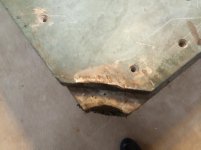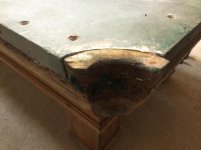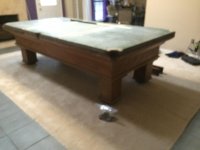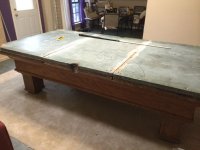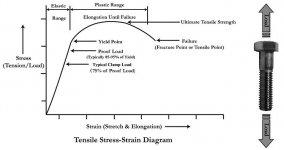I bought this old table off a couple that needed to clear it out of their garage for space to park their car. It has some damage, but it's a beautiful table and I love it.
The issues I've found since moving it, that I could really advice on are:
1. The slate at two corner pockets had been broken near the very edge, and now make what was a round edge for the ball to drop over, a 45 degree line that connects the two edges of slate. (Will add pictures soon.)
My game plan as of now is to pay a wood worker to try and mimic the other corners the best he can and fill in the gap?
2. And this is the biggy. Two places for the rail bolts, where they bolt into the slate, will not give purchase to the bolts. Either something is jammed or broken off deep inside, or the threading is completely stripped out. I'm considering using a long narrow dril bit to break it up? But I'm timid about that undertaking.
3. The yahoo before me, used 3 inch wood screws to hold the rail on. (Just screwed through the exterior of the rail and into the wood right below the slate ) wondering if I should patch the holes... Or maybe take it to a professional of some kind?
4. The leather pockets are original. Along with their brackets. So very old, and have broken in a few places... Would it hurt the value more to get replica pockets? Is there some way to fix them? The gold trim around the pockets (little braided fabrics hanging off) are still there on 4 pockets. Missing on two. Again should I use replica parts for them or just take them off?
5. should I try and remove the glue that held on the old felt? I'm having a professional come refelt it next Friday. Want to make sure it's ready for him.
Just cleaned it, base looks beautiful. Looking forward to hearing your thoughts. Thanks for your time reading!
The issues I've found since moving it, that I could really advice on are:
1. The slate at two corner pockets had been broken near the very edge, and now make what was a round edge for the ball to drop over, a 45 degree line that connects the two edges of slate. (Will add pictures soon.)
My game plan as of now is to pay a wood worker to try and mimic the other corners the best he can and fill in the gap?
2. And this is the biggy. Two places for the rail bolts, where they bolt into the slate, will not give purchase to the bolts. Either something is jammed or broken off deep inside, or the threading is completely stripped out. I'm considering using a long narrow dril bit to break it up? But I'm timid about that undertaking.
3. The yahoo before me, used 3 inch wood screws to hold the rail on. (Just screwed through the exterior of the rail and into the wood right below the slate ) wondering if I should patch the holes... Or maybe take it to a professional of some kind?
4. The leather pockets are original. Along with their brackets. So very old, and have broken in a few places... Would it hurt the value more to get replica pockets? Is there some way to fix them? The gold trim around the pockets (little braided fabrics hanging off) are still there on 4 pockets. Missing on two. Again should I use replica parts for them or just take them off?
5. should I try and remove the glue that held on the old felt? I'm having a professional come refelt it next Friday. Want to make sure it's ready for him.
Just cleaned it, base looks beautiful. Looking forward to hearing your thoughts. Thanks for your time reading!
